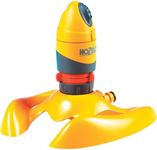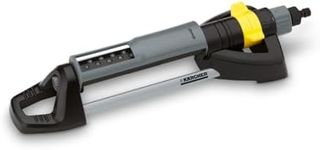Buying Guide for the Best Lawn Sprinklers
Choosing the right lawn sprinkler is essential for maintaining a healthy and lush lawn. The right sprinkler will ensure that your lawn receives the appropriate amount of water, evenly distributed across the area. When selecting a lawn sprinkler, consider the size and shape of your lawn, the water pressure available, and any specific watering needs your plants may have. Understanding the key specifications will help you make an informed decision that suits your lawn's requirements.Sprinkler TypeThe type of sprinkler is crucial as it determines the coverage pattern and suitability for different lawn shapes. Common types include oscillating, rotary, stationary, and impact sprinklers. Oscillating sprinklers are ideal for rectangular lawns, providing even coverage with a back-and-forth motion. Rotary sprinklers are better for circular or irregularly shaped lawns, as they rotate to cover a wide area. Stationary sprinklers are best for small, specific areas, while impact sprinklers are suitable for large areas with high water pressure. Choose a type that matches the shape and size of your lawn for optimal coverage.
Coverage AreaCoverage area refers to the maximum area a sprinkler can water effectively. This is important to ensure your entire lawn receives adequate water without overwatering or missing spots. Coverage is usually measured in square feet or meters. For small lawns, a sprinkler with a coverage area of up to 1,000 square feet may suffice. Medium lawns might require coverage between 1,000 to 3,000 square feet, while large lawns may need sprinklers that cover over 3,000 square feet. Assess your lawn's size and choose a sprinkler that can cover it efficiently.
Water Pressure RequirementsWater pressure requirements indicate the minimum and maximum pressure at which a sprinkler operates effectively. This is important because insufficient pressure can lead to poor coverage, while excessive pressure can damage the sprinkler or cause water wastage. Water pressure is measured in pounds per square inch (PSI). Most residential sprinklers work well with a pressure range of 30 to 50 PSI. Check your home's water pressure and select a sprinkler that matches it to ensure optimal performance.
AdjustabilityAdjustability refers to the ability to modify the sprinkler's spray pattern, distance, and direction. This feature is important for customizing the watering to suit different areas of your lawn. Some sprinklers allow you to adjust the spray angle and distance, which is useful for avoiding sidewalks or driveways. Others offer adjustable patterns to accommodate various lawn shapes. If your lawn has diverse watering needs, look for a sprinkler with high adjustability to tailor the watering to each section.
DurabilityDurability is a measure of how well a sprinkler can withstand regular use and exposure to the elements. This is important for ensuring the longevity of your investment. Sprinklers made from high-quality materials like metal or heavy-duty plastic tend to last longer and resist damage from sun, water, and physical impact. Consider the climate and conditions in your area, and choose a sprinkler that can endure them without frequent replacements.










![HOZELOCK - Rectangular Sprinkler Plus 220 M: Ultra Coverage, Sprinkler on Sled, Ideal for Lawns, Adjustable Oscillation Zone: 16 Jets For Uniform Watering [100-100-250]](https://images-proxy.bestreviews.guide/3TmhTg9q_9rggf_9gEoVnfXAOXM=/0x150/https://m.media-amazon.com/images/I/31rk-njBTXL._AC_CX679_.jpg)

![HOZELOCK - Sprinkler Rotating 177 m² : Spike-mounted Spray Sprinkler for Medium-sized Surfaces (ø 15m), Ideal for Lawns and Established Plants, 8 Jets: 2 Spray Patterns [2510P0000]](https://images-proxy.bestreviews.guide/_hyZsvKqoyhnmRql15QlT5BxdmU=/0x150/https://m.media-amazon.com/images/I/31X7f26Kh1L._AC_CX679_.jpg)

